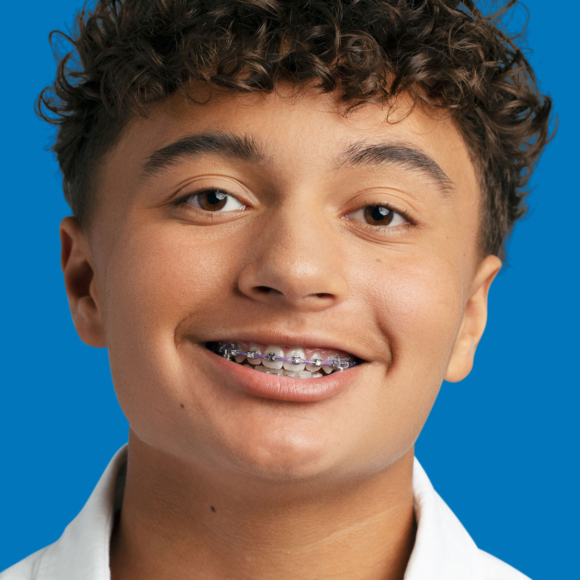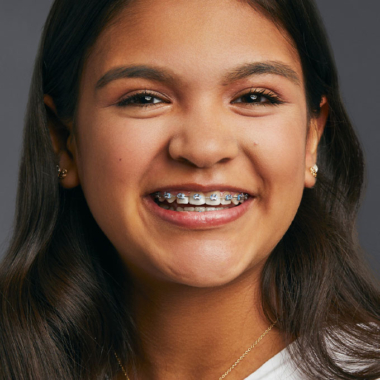Orthodontic Braces for All Ages
We treat every smile with a customized plan using traditional metal or ceramic/clear braces to ensure you’re getting the best possible orthodontic option — with results you’re proud to share. Learn more when you schedule your FREE braces consultation today with an orthodontist in Wausau and Antigo, WI.

Types of braces

Traditional Metal Braces
Metal braces are the most common type and have been used to straighten teeth for centuries. Made of high-grade stainless steel and combined with elastic ties or bands to gently move teeth as prescribed, traditional metal braces can help create that perfect smile.
Plus, Dr. Dovorany can start your traditional metal braces treatment the same day you come in!
Clear/Ceramic Braces
Ceramic or clear braces are less noticeable on the teeth because, as the name suggests, they’re either clear or tooth-colored. Ceramic brackets gradually realign your teeth to help perfect your smile, just like traditional metal braces. They’re popular with adults because they’re a bit more discreet than metal braces.
And for those who want an even more discreet treatment approach with more flexibility when it comes to diet and oral hygiene, we also offer clear Invisalign® aligners . In fact, we treat more patients with this approach than about 99% of other practices, so Dr. Dovorany is a leader in Invisalign treatment — and the cost is comparable to braces!

Let us help you decide when you book a free consult.
Braces FAQs
What foods should I avoid while I have braces?
There is really only a small list of food to avoid while wearing braces. This is to prevent damage to the brackets or to prevent food particles from becoming trapped between the brackets and wires. Foods to avoid include:
- Chewy foods such as fruit leathers, beef jerky or bagels
- Highly crunchy foods like raw carrots, chips, raw celery, and popcorn
- Sticky foods like caramel candy, licorice, and marshmallows
- Very hard foods like hard candy, hard breadsticks, or pizza crust
- Any food you have to bite into such as apples or corn on the cob. (You can still enjoy these foods by slicing the apples or removing the corn from the cob!)
How do I brush my teeth with braces?
- Before brushing, do a quick rinse with water. This will dislodge any food particles stuck between the wires or brackets.
- Brush beginning at the gum line, using a 45-degree angle of approach. As you move towards the brackets brush from both the top and the bottom, ensuring that the bristles reach under the wires and around the brackets. This process may take some extra time in the beginning, but once you are used to it, it will be routine for you.
- Follow up with thorough flossing. You will need to use a precise and careful flossing technique to make sure you do not dislodge or loosen the brackets or wires. Your doctor will help you how to perfect your flossing technique during your appointment.
Are braces painful? How do I ease the pain?
Generally, braces are not painful. However, you may feel a little sore or uncomfortable immediately after you first get them. This soreness is normal, and it will not last long.
A saltwater rinse can help relieve the soreness and inflammation. Dissolve a single teaspoon of salt in a full cup of lukewarm water and swish around your mouth for a few minutes. If soreness persists, you can take an over-the-counter pain reliever such as ibuprofen or acetaminophen. If you experience lip, cheek, or tongue irritation in the weeks after getting braces, some wax can alleviate the problem quickly.
How long will I have to have braces?
The amount of time that you will need to wear braces varies, depending on several things, such as the severity of your bite problem. Most patients need to wear braces for 12 to 24 months, but this can be shorter or longer depending on your case. We’ll discuss this with you and give you a general idea of what you can expect.
After several months of wearing braces, we can measure progress more easily, and we can more accurately update you regarding how much longer you can expect to wear braces.
How long does it take to see the results from braces?
This largely depends on each patient’s specific orthodontic issues. In general, treatment times range from 6 to 30 months (about 2 and a half years). The “average” time frame a person is in braces is approximately 22 months (about 2 years).
Can I get braces that are less noticeable?
Yes! Because not everyone is proud to flash that coveted “tin grin” smile, we offer clear/ceramic braces. They are more discreet and just as effective as metal braces. In addition, you might consider Invisalign® aligners, which offer an even more inconspicuous look during treatment and more dietary flexibility—all with potentially the same results, depending on your needs. The cost is equivalent to braces, too!
Is it too late to have braces if I am already an adult?
A surprising percentage of our patients are adults. In fact, no patient is “too old” to wear braces! What’s more, if you have dental insurance, there’s a good chance you have orthodontic benefits, so why pay for benefits you’re not using? We accept most plans and can help you make the most of your coverage, so book a free consult and start your new smile adventure at any age!
How much do braces cost in Wisconsin?
Unfortunately, it is impossible to give the exact cost for treatment until we have examined you. We will cover the total cost and payment options during your consultation. We have many financing options available to accommodate your needs, and we will review these with you. We will also review your insurance policy (we accept most plans), help to maximize your benefits, and file your claims. We have clinics conveniently located in Wausau and Antigo, WI so choose the one closest to you!



